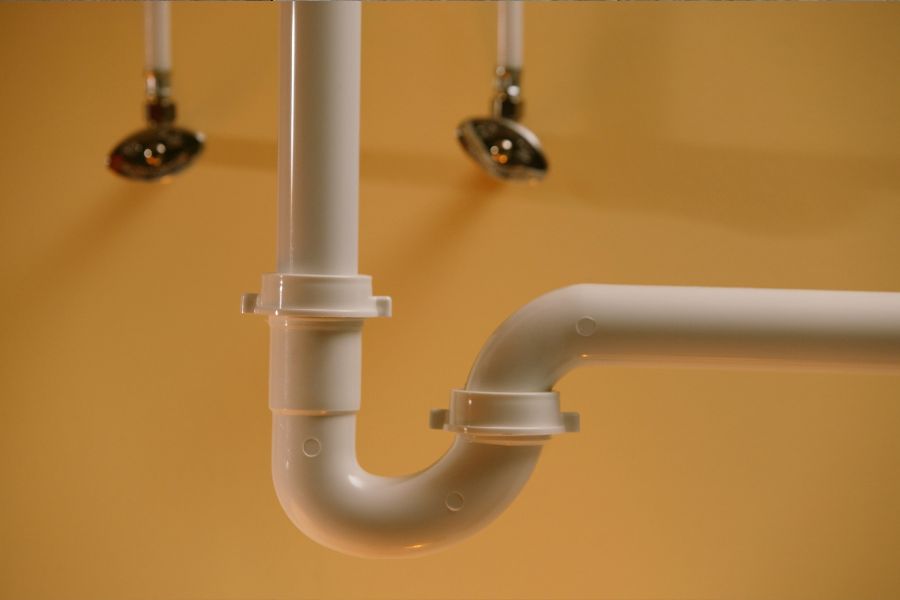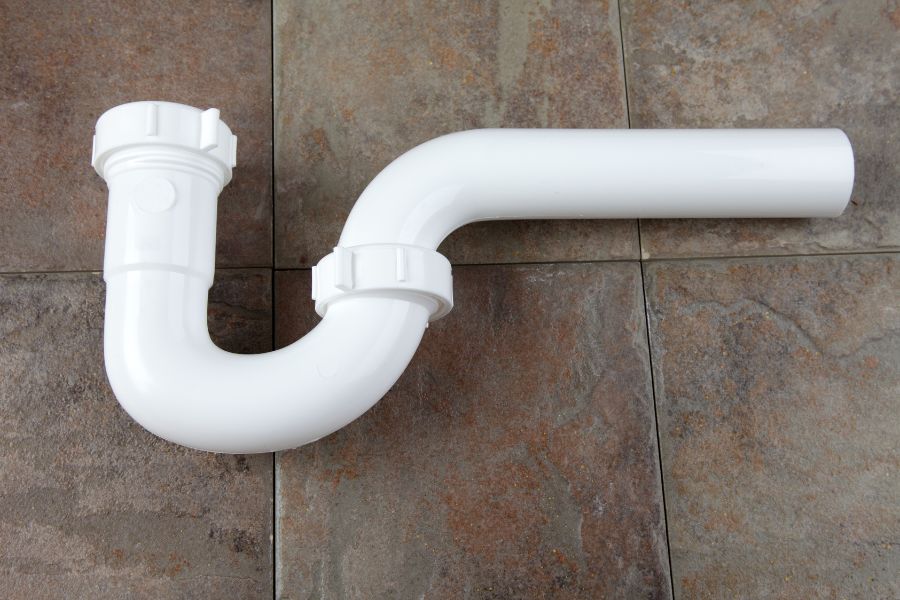Homeowners remodeling a shower in their bathrooms often run into trouble with drains. Many wonder if a drain needs a -Ptrap, and despite what you may have heard, the answer is simple.
Every shower drain is required to have a P-trap in the United States, whether the shower is in a home, an apartment building, or a gym.
These traps are an essential part of the home’s plumbing system, and when they fail, you will begin to notice the effects immediately. Foul odors are the first sign there’s a problem, but only one reason that all showers need a drain trap.
With that in mind, we will break down how traps work and what happens when there’s a problem. That includes tips on fixing a clogged P-trap and alternative options for certain situations.
How Does a Shower Drain Trap Work?
Everyone is familiar with a shower drain. It’s where the water from a tub or shower goes, but beneath every drain is something called a trap.
Under a kitchen or bathroom sink, it’s often referred to as a P-trap because of the shape, but these traps are also called a U-trap or S-trap.
P-traps are found below showers and sinks in homes throughout the United States. Water flows from the drain into the inlet before entering the P-trap.
This section of pipe always holds a small amount of water and creates an airtight seal. When working properly, water from a shower pushes the old water through the P-trap to the next section and down the drain pipe.
While it may seem more efficient to have a straight pipe sending water directly to the drain, the unique shape of these drains serves a special purpose.

Do Showers Need a Trap?
The main reason every shower needs a P-trap is to prevent sewer gases from coming back up into the shower.
Drain lines contain all kinds of nasty substances, including sewer gases. Water in the P-trap actually “traps” things to keep them from coming back through the drain line and into your home.
That includes bugs, drain flies, and noxious smells far fouler than anything someone could leave behind in a commode.
Shower P-traps are different from the ones found under sinks with a less pronounced curve in many cases and access to a cleanout.
Building code requirements vary worldwide, but if you live in the United States, it’s required by law to have a P-trap in a shower drain.
Show Trap Problems and Fixes
You can’t see the P-trap from inside a shower, but you will know when there’s a problem. It could be in the form of small flies that come from black worms around shower drains.
While that’s not pleasant, neither are clogs, which is the first sign there could be an issue with the shower P-trap.
Odors are another common problem with shower P-traps, especially ones installed too far from the drain. A P-trap can also dry out or crack.
If the vent pipes on a home are damaged, the water that’s supposed to remain in the trap could be forced out, causing it to become dry. This also occurs in humid areas and shower stalls that haven’t been used in a while but are easy to fix.
For dry and undamaged shower traps, pour water down the drain once a month to keep a fresh supply of clean water in the P-trap until it has been put back into use.
If you have damaged vent pipes, a clogged drain, or a faulty P-trap, following these tips will have your shower back to normal in no time..
How To Clean Shower P-Trap
If you have a clogged drain in the shower, the problem could lie just below the drain in the P-trap.
It’s not something a few pots of hot water can take care of, but you can clear up the issue using simple household ingredients, chemical cleaners, or a few simple tools.
Method 1: Baking Soda and Vinegar
This popular method has been used to clear sink and bathroom drains for decades, and it’s the most natural approach to tackle a P-trap for shower drains.
You only need a bit of baking soda, distilled white vinegar, and maybe an hour of your time to clear P-traps using this method.
Step 1: Mix Baking Soda and Vinegar
Using a measuring cup, take around 1/3 cup of baking soda and pour it into the shower drain. Follow that with the same amount of vinegar. You can also use apple cider vinegar and increase the amount to a half cup if needed.
Step 2: Wait and Rinse
When you pour the vinegar down the drain, you should see or hear fizzling as it interacts with the baking soda in the drain pipe and P-trap.
This mixture will loosen any gunk around the drain that could cause odors and can remove minor blockages or hair and soap scum in the shower P-trap.
Wait for up to 30 minutes and pour warm water down the drain to clear the mixture. You can repeat this process every few months to ensure the P-trap and drain stay clear.
Method 2: Drain Cleaner
Chemical drain cleaners are something found in millions of bathroom closets and cabinets. They are quick, effective, and a great way to clear a stubborn clog from a shower P-trap.
There’s no perfect solution for every shower drain, but we highly recommend using something safe for all kinds of plumbing, including old cast-iron pipes and PVC. With that in mind, Green Gobbler is an excellent option that’s been well-received by homeowners trying to clear a P-trap.
This cleaning package comes with small drain snakes, which may help you dislodge whatever is causing the problem in the P-trap or shower drain. Just pay attention to what’s in the cleaner, or you could risk damaging the plumbing or even a bathtub.
Enzymatic cleaners are the safest to use on P-traps, and there are specialized products designed for main drain lines as well.
Method 3: Use the Cleanout
Some, but not all shower drain traps will have something called a cleanout. When accessible, you can open up the pipe and access the P-trap to clear any blockage.
With a P-trap under a sink that only requires loosening a few nuts and draining the excess water from the bowl.
When the P-trap is located under a bathtub or shower, you’ll need access to the home’s plumbing system beneath the floor for these P-traps.
When you have clear access to the shower P-trap, you can unscrew a section, drain the water, and clear the blockage.
It also provides better access if you want to use a short auger or plumber’s snake to push a blockage through.

Traps that are exposed like the one in the photo above are glued into place. In these instances, you’ll have to cut the P-trap loose and replace it with a new one which brings us to installing and replacing a P-trap.
P-Trap Installation
Replacing a P-trap under a kitchen sink is something any homeowner can accomplish in under 30 minutes. If you need to replace or even remove a P-trap connected to a shower drain, it could be time to call in a professional.
If you have exposed plumbing in a basement that gives you free access to work, you may be able to replace a P-trap in a shower.
If the home doesn’t have a basement or a small crawl space, you may have to go through the shower floor instead of coming at the P-trap problem from below.
As you can imagine, removing a bathtub, flooring, or having to chip up concrete in a shower stall isn’t something simple.
You also have to consider the slope of the plumbing from the drain and the time it takes to get the job done if it’s the only shower available to use.
Keep in mind that the process will vary depending on the type of shower, how the home is built, and access to the plumbing in general.
This video is a great example of what to expect when you don’t have free access to plumbing from a basement and want to install a P-trap.
P-trap Alternatives
One of the issues with homeowners wondering if a shower drain needs a P-trap are building codes and the availability of other types of drain traps.That leads people to look for P-trap alternatives like drum traps, bottle traps and bell traps.
Building restrictions vary throughout the world, so what’s allowed in the United States may not be acceptable in Canada.
Some codes also differ from one state to another, so check on the building codes for your area before thinking about using one of the more popular P-trap alternatives.
As we mentioned, codes for plumbing are different, and the Bottle Trap is something you may have heard of if you’ve lived or traveled overseas. Bottle traps have been used in European countries for years, and they are a unique P-trap alternative
A bottle trap serves the same purpose as a P-trap with a design to prevent sewer gasses and bugs from getting back into the bathroom. They are incredibly popular in European bathrooms – especially those short on space.
It’s not what you install under a bathtub or shower, however. Bottle traps are used under sinks and may violate building codes in your area.
A Shallow P-Trap is more common and ideal when there’s limited space for a tub or shower drain. They can also be a code violation, even with a connector and plug.
The Hepvo waterless valve is another style you may encounter but are only suitable for RVs.
Only use a trap designed for showers in a shower. Never attempt to use a bottle trap or anything designed for foreign fixtures in the United States or you risk code violations.
The Bottom Line
Once you understand the importance of using a P-trap in a shower, you know why they are required in homes throughout the United States.
A P-trap is something you may never set eyes on, but you’ll recognize there’s an issue when you experience foul odors or standing water.
If you’re having difficulties getting a bathtub to drain or have standing water in a shower, these tips could save you a trip from a professional plumber.
FAQ
Is a P-trap Better Than an S-trap in Shower Drains?
S-traps were produced before P-traps and took up a considerable amount of space. They are usually replaced by newer types of traps – not used under a shower or tubs.
Should You Always Have Standing Water in a Shower Drain?
It’s not uncommon to look down and see a bit of standing water below the drain in the P-trap if it’s shallow. If you don’t see water, that doesn’t mean the P-trap is dry, however.
Can You Use a Grease Trap With a Shower Drain?
No, and you can rest assured that’s a code violation in most areas. A grease trap is for grease, and not a suitable P-trap alternative.
